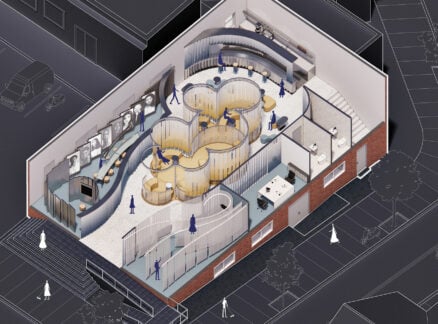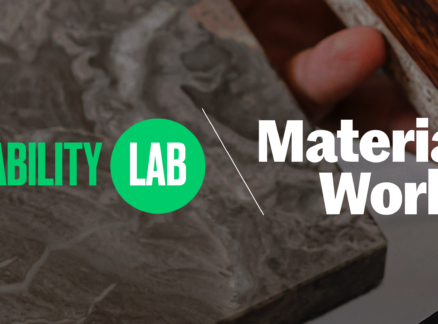October 1, 2005
Growing Pains
The Salone del Mobile is moving into an enormous new facility—and launching two international spinoffs.
It was supposed to be the icing on the cake, a small hyperselective export version of Milan’s Salone del Mobile staged over a long May weekend, which New York mayor Michael Bloomberg had proclaimed “Design Week.” It featured the best in Italian furniture and fixtures, along with an edible kitchen parmigiano table and fettucine chairs. But for many of the exhibitors who took part in it, the inaugural version of New York’s i Saloni WorldWide was more lemon than lemon torta. “I think this facility is more suited for a show of machine tools than it is for fine Italian design,” observed Valerio Mazzei, president of Edra, a family-owned furniture company located in Perignano, outside of Pisa, as he glanced down the sparsely peopled rectilinear halls of the former marine passenger terminal in Manhattan that housed the Italian show. Expected to draw more than 12,000 visitors, the New York i Saloni attracted just under 7,000 between May 14 and 17. “I’m pleased to have been part of this,” Mazzei says. “And it’s not a bad first attempt. But I don’t think this is an environment where we can best express ourselves. More importantly I don’t think the architects and designers who came here feel that they’ve seen an exceptional exhibit.”
Staged at Manhattan’s Piers 90 and 92—just down the dock from the slip that hosts the 1943 U.S. Navy Essex Class aircraft carrier USS Intrepid—i Saloni WorldWide was conceived to allow 60 Italian designers and manufacturers a chance to outshine exhibitors at Downtown, in Chelsea, and the International Contemporary Furniture Fair (ICFF), at the Javits Center, which is sponsored by Metropolis. The ICFF, where the Italians used to show, drew more than 21,000 visitors during the same weekend. “We wanted to do something on our own,” says Manlio Armellini, managing director of Cosmit, the Milan-based firm that administers the Salone del Mobile. “We believe we have a higher standard of quality and creativity than the firms displaying at the other fairs. We want to present the things we choose in the manner we choose.”
New York’s i Saloni WorldWide was also the first step in an ambitious program designed to establish annual editions of the Salone del Mobile outside of Italy to complement the annual show in Milan, as well as reinforce Italy’s market presence abroad. This October i Saloni Worldwide will bring 150 Italian companies to the Crocus Expo, in Moscow. With exports to North America dipping after having peaked at over $1.8 billion in 2002, Russia is an increasingly important market for Italian manufacturers. Sales of Italian furnishings there rose nearly 31 percent from 2003, to about $470 million in 2004, and a similar or greater increase is expected for 2005.
Cosmit directors are contemplating producing additional editions of i Saloni WorldWide in Asian and other North American venues in the future. “It is important that Italian industry participate in these exhibitions to promote the image of our country,” says Carlo Guglielmi, president of the Milan-based lighting and furniture manufacturer FontanaArte as well as of Euroluce, the international lighting exhibition held biannually in Milan. “The exportation of the Salone del Mobile is a necessary step. A single company cannot express itself alone abroad. When we travel together we form a critical mass of quality. And all of us benefit.”
Along with a desire to promote Italian creativity and designers, the directors of i Saloni are spurred by acute competition with other formerly regional fairs that attract an increasingly international crowd. Like the Salone del Mobile, several of these rival shows are eagerly testing the global waters. The London-based 100% Design recently launched a show in Moscow; this year’s inaugural Las Vegas Market featured highlights from the 2005 IMM International Furniture Fair, in Cologne.
Yet the most dramatic change for the Salone del Mobile does not involve an overseas adventure but the transfer of the trade’s premier show from its traditional home near the center of Milan to a newly completed facility outside the city. Founded in 1961 to help Italian furniture manufacturers compete with the Scandinavian firms that threatened the European and North American markets, the Salone del Mobile grew rapidly, with exhibitors almost doubling, space and visitors nearly tripling, during its first four years. First staged in two pavilions of the Fiera Milano—Milan’s historic urban exhibition space—the fair soon expanded to occupy the entire 3.7 million-square-foot facility. Visitors were drawn by the quality of the objects and charmed by the possibility of attending the many off-site events held in nearby Milan shops, hotels, palazzos, and restaurants. An estimated 250 Salone exhibitors stage events in the city center—including up-and-coming designers looking to save on expenses as well as big names such as Cappellini, Poltrona Frau, and B&B Italia—hoping to capitalize on the fascino of Milan. With the introduction of the new Fiera Milano facility, the unique symbiosis between fair and city that distinguished the Salone from all other fairs will undoubtedly change.
In March Italian premier Silvio Berlusconi—a Milan native—helped inaugurate the new Fiera Milano facility in the municipalities of Rho and Pero, about 16 miles north of Milan. The new venue will host its first Salone del Mobile next April; the traditional facility, now baptized Fiera Milano City, will be downsized to about one-third its present footprint. Built in just 24 months at a cost of $927 million on the site of a former oil refinery, the new Fiera Milano is physically and aesthetically superior to the urban site. It covers an area of 5.7 million square feet, of which 3.7 million square feet serve as exhibition space. Designed by architect Massimiliano Fuksas and set in a broad swath of green cultivated from reclaimed land, the new facility includes eight pavilions, each outfitted with state-of-the-art utility, ventilation, and data systems—and large enough to contain the Vatican’s St. Peter’s Square. The site accommodates 10,000 automobiles; space for another 10,000 will be constructed about a mile away.
The new Fiera Milano is a 25-minute drive from Milan’s Malpensa airport and a 15-minute drive (traffic permitting) from the center of the city. Milan’s number one subway line, which currently serves the old Fiera Milano, is slated to be extended by an additional stop to reach the new facility. Plans are also under way to create a national railway stop at the site by 2007 for travelers along Italy’s main rail lines. A station for the TGV train coming from France is also in the works.
Officials at Fiera Milano and the Salone del Mobile consistently downplay any concern that the Milan show will lose some luster as it migrates farther away from the city center. “Milan is not New York,” says Michele Perini, president of Fiera Milano. Listed on the Milan stock exchange, the site hosts 70 exhibits each year. “You can get across town from Piazza Castello to Porta Venezia in thirty minutes. People can easily spend their days at the new Fiera and their nights in the city center.”
For Cosmit’s Armellini, the new facility was an absolute necessity for the future of the Salone del Mobile. “We were the first group to ask Fiera Milano to look for a new site,” he says. “It may mean that visitors and exhibitors will experience the Salone in a more contained way—visit here all day, then go back to the city and change for dinner.”
Even those exhibitors who expressed disappointment at i Saloni’s New York debut were more optimistic than skeptical about the Salone’s new Rho-Pero home. “The new facility may not have the magic of downtown Milan,” says Edra’s Mazzei, gazing down the corridor of Pier 90 as he relaxed on one of his company’s Modernist white leather divans. “But if it is done with taste, it could be something even more extraordinary—a modern, magical place where new objects can be properly presented. I know this may seem far-fetched. But today in New York, design people are more interested in downtown than they are in Midtown. Forty years ago this would have been inconceivable.”





